Perfusion by blood provides tissues with vital oxygen and nutrients, while removing waste products and distributing signalling molecules around the organism. The measurement of microvascular blood perfusion provides researchers with critical information in a number of research applications where blood supply has been disrupted.
Our blood flow monitors will be of interest therefore to life scientists wishing to directly and continuously measure local microvascular blood perfusion in in vivo models of ischemia-related disorders.
Our OxyFlo™ devices are laser Doppler flowmetry (LDF) monitors intended for monitoring of relative microvascular blood flow in living tissues.
Most applications are concerned with monitoring the competence of regional (microvascular) blood supply in specialties such as:
Oxford Optronix Ltd. was founded when its current CEO pioneered the transition of the then nascent laser-Doppler flowmetry technology into a commercially viable product in the early 1990's. We remain a pioneer in the development of LDF technology and continue to set standards of reliability, robustness and sensitivity, with the OxyFlo™ brand now well-established the world over in biomedical ischaemia research.
In the OxyFlo™ Pro, our third-generation laser Doppler platform, we blend contemporary design, plug and play convenience and touch-screen operation to provide one of the most advanced and reliable blood flow monitors on the market.
Intended use statement:
OxyFlo™ and OxyFlo™ Pro are intended for laboratory, industrial and research use only.
Feature | OxyFlo | OxyFlo Pro |
| Number of channels (max number of sensors supported) | 1 | 2 (OxyFlo Pro) or 4 (OxyFlo Pro XL) |
| Simultaneous blood perfusion and backscatter measurements supported | Yes | Yes |
| Optional unfiltered (RAW) or artifact rejected (ART) blood flow outputs | No | Yes |
| Analogue data outputs | Yes | Yes |
| USB digital data output | Yes | Yes |
| 2 year product warranty | Yes | Yes |
| Touchscreen display | No | Yes |
| Upgradable (addition of channels) | No | Yes |
Our latest OxyFlo™ laser Doppler tissue perfusion monitors are employed the world over for the continuous assessment of tissue blood flow in ischaemia-related research focussed on acute experimental models of peripheral vascular disorders, stroke and cerebral ischaemia, angiogenesis, vital organ vitality, transplantation, and more.
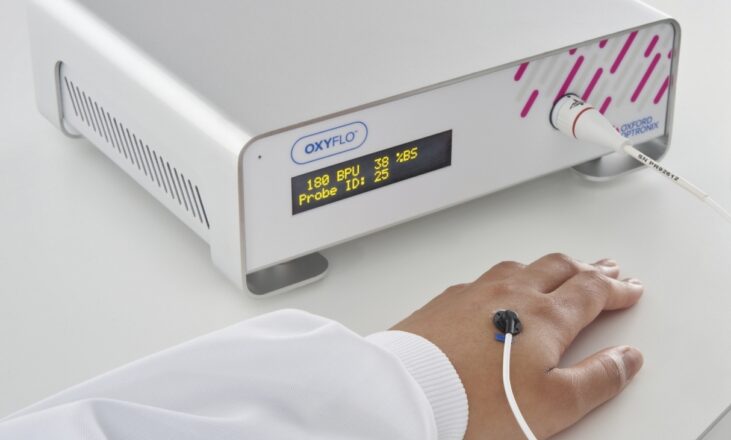
A range of probe types supports a host of specialist disciplines and applications requiring both invasive or non-invasive tissue blood flow assessment.
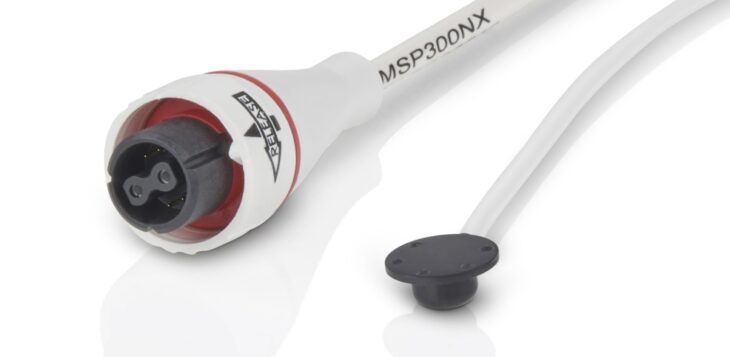
Our multi-channel OxyFlo™ Pro monitors incorporate a proprietary artefact rejection technology, effectively filtering out the presence of motion artefacts in the blood flow signal. It substantially reduces, and in most cases eliminates motion artefacts or ‘spikes’ in the blood flow data arising from sensor cable movement and/or regular tissue movement (e.g. generated by breathing motion).
Our third-generation laser Doppler opto-electronics ensure industry-leading sensitivity, stability, and accuracy, while one-time probe calibration and automatic probe identification mostly eliminate calibration procedures. Probes supplied at the time of monitor shipment are supplied fully factor pre-calibrated.
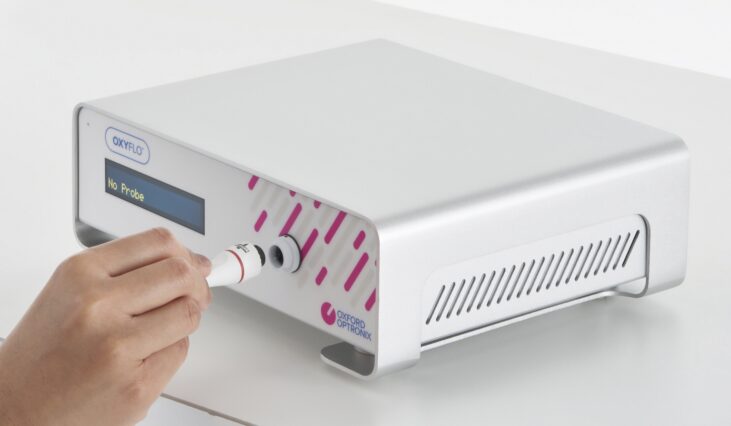
The OxyFlo™ Pro is available as a 2-channel or as a 4-channel device for the simultaneous measurement from up to 4 probes. This provides the flexibility to monitor blood flow from multiple tissue regions (e.g. in the comparison of pathological versus control tissue). Furthermore the Pro models feature a touch-sensitive, high-contrast, high viewing-angle display, providing real-time data in both digital and graphical (trace) formats, and access to additional instrument settings.
OxyFlo™ monitors are configured for use in a stack arrangement alongside our OxyLite™ dissolved oxygen monitors, supporting the simultaneous measurement of tissue oxygen and blood flow using unique multi-parameter sensors.

Our entire range of tissue monitoring devices offers a choice of traditional 0-5V analogue outputs and a digital (USB) data output that supports direct streaming to the popular LabChart® Pro charting software by ADInstruments. After installing a complimentary add-on, LabChart will automatically identify the specific type and model of monitor and pre-load all the necessary configuration and channel settings, providing the ultimate in ‘plug and play’ convenience. For researchers wishing to make multi-parameter measurements, the add-on supports multiple Oxford Optronix devices at the same time.
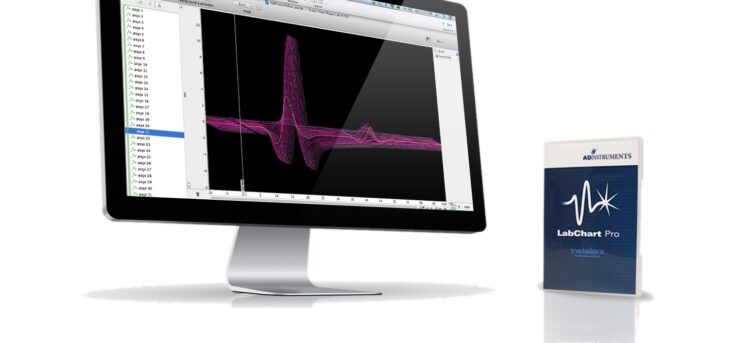
Our monitors are provided with a comprehensive 2-year manufacturer’s warranty, covering defects in material or in workmanship. Optional extended warranty packages including preventative maintenance servicing are also available for additional peace of mind.
Technical and application support is both comprehensive and free throughout the lifetime of our products. By purchasing our products you are buying into an unprecedented knowledge base borne out of years of product experience by our support staff, many of whom have a research background themselves. We provide personal and responsive assistance via on-site visits, video calls, or email and will 'go the extra mile' to ensure that our users can extract the very best value and opportunity from our products.
by Justin Croft, 24 November 2022
Our OxyFlo™ and OxyFlo™ Pro blood flow monitors are employed the world over and have been cited widely across many research applications.
Daneva Z, Dempsey SK, Ahmad A, Li N, Li P-1L and Ritter JK (2019). Diuretic, natriuretic, and vasodepressor activity of a lipid fraction enhanced in medium of cultured mouse medullary interstitial cells by a selective FAAH inhibitor. Journal of Pharmacology and Experimental Therapeutics
Ganesh T, Zakher , Estrada M and Cheng HM (2019). Assessment of microvascular dysfunction in acute limb ischemia-reperfusion injury. J Magn Reson Imaging
McBride DW Reis C, Zhang JH, Applegate R 2nd and Tang J (2018). Remote Limb Ischemic Preconditioning Attenuates Cerebrovascular Depression During Sinusoidal Galvanic Vestibular Stimulation via α1-Adrenoceptor-Protein Kinase Cε-Endothelial NO Synthase Pathway in Rats. J Am Heart Assoc
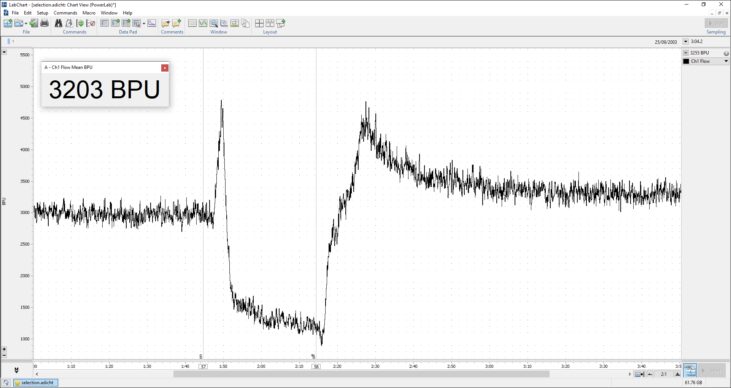
A dedicated needle blood flow probe (product code 'MNP100NX-3/10'), immobilized over a pre-determined region of the skull via a stereotactic apparatus was used to non-invasively measure cerebral cortex blood flow in response to temporary MCA occlusion. The trace shows continuous blood flow in arbitrary 'blood perfusion units' (BPU) and its response to a period of occlusion, followed by release.
What physiological parameters does OxyFlo™ measure?
Our range of laser Doppler blood flow monitors are intended for the investigation of blood flow (also known as blood perfusion or microvascular blood flow) at the tissue level. The laser Doppler technique is well-established as the most convenient method for assessing continuous tissue blood flow at one or more tissue locations via fibre-optic probes in direct contact with the tissue. The measurement of blood flow provides researchers with critical information in a number of research applications where blood supply has been disrupted (ischaemia). The technique is not intended for the assessment of blood flow rates (in units of flow volume/min) in isolated blood vessels.
What makes the OxyFlo™ unique?
While substantially equivalent to other laser Doppler monitors on the market, our OxyFlo™ monitors offer a number of distinguishing key features. Most notable of these is their ability to operate in conjunction with our counterpart oxygen monitors for combined tissue oxygen, blood perfusion and temperature monitoring from a single sensor and tissue micro-region. Furthermore, our multi-channel OxyFlo™ Pro models offer an industry-first touch-screen display and user interface as well as an optional intelligent signal noise suppression output (ART).
What are the typical applications for OxyFlo™?
Our instruments have proved popular in applications covering such disciplines as peripheral vascular disease, cerebral perfusion monitoring in models of stroke and brain injury, tumour perfusion monitoring / angiogenesis, vital organ monitoring, transplantation surgery, wound healing, and more.
How does OxyFlo™ work?
Our OxyFlo™ monitors utilise the well-established method of laser-Doppler Flowmetry (LDF) to provide a continuous output of tissue blood blow. LDF works by illuminating a small region of tissue under observation with low power laser light from a sensor containing optical fibre light guides. Laser light from one fibre is directed towards the tissue and is scattered within the tissue. Some of the scattered laser light is incident upon moving red blood cells within the tissue and this light becomes Doppler-frequency shifted as a result. A second optical fibre collects this backscattered, Doppler-shifted light from the tissue and returns it to the detector within the monitor. The photo-detected signal comprises a broad spectrum of Doppler frequency shifted signals generated as a result of the movement of red blood cells within the tissue. Microvascular blood flow is electronically calculated as the product of mean red blood cell velocity and mean red blood cell concentration in the volume of tissue under illumination from the sensor.
What are OxyFlo™ probes made of and how large are they?
All our blood flow probes are constructed internally from glass or specialist plastic optical fibre light guides, terminating in needle, surface or other, specialist conformations designed to support the measurement of blood flow from almost any tissue. Probes are typically supplied in 3 m lengths and composed of specialist surgical steel, medical grade plastic and silicone materials. See here for a full list of available blood flow probe types.
Do OxyFlo™ monitors support the use of multiple probes at the same time?
Yes, the OxyFlo™ Pro is a two-channel monitor, while the OxyFlo™ Pro XL is a four-channel monitor capable of simultaneously driving and reading from up to 4 blood flow probes simultaneously. This allows the simultaneous collection of physiological blood flow data from up to four separate tissue sites at the same time, which may be useful when comparing pathological versus control tissue sites (e.g. contralateral cerebral perfusion). The ability to monitor from more than one tissue site can also be useful in compensating for natural site-to-site blood flow variability by allowing multi-site signal averaging.
Are OxyFlo™ probes supplied sterile?
No. While we manufacture blood flow probes in a clean laboratory environment, they are not supplied sterile. Our blood flow probes can however be disinfected using 70% IMS or ethanol, and can be sterilized using industry-standard liquid sterilizers (e.g. Cidex®) or the low-temperature ethylene oxide (ETO) gas method. Note that neither our blood flow probes, nor our blood flow monitors possess regulatory approval for use in human subjects.
What is the sampling volume of OxyFlo™ probes?
For most tissues the mean sampling depth is in the region of 0.5 – 1.5 mm with a typical sampling volume in the region of 1 mm3. These values could be higher in regions where reduced photon absorption would be expected due to depleted erythrocyte concentration. These values have been obtained heuristically through many years of experience and are based on both in vitro observations and mathematical modelling of photon diffusion through ‘imaginary tissues’ using Monte-Carlo techniques.
What are the units of microvascular blood flow?
The laser-Doppler technique for tissue blood flow measurement provides arbitrary, non-absolute, units of blood perfusion since the actual sampling volume/depth can only be determined by identifying which erythrocytes have interacted with the light remitted from the tissue, which in turn, is principally dependent on two parameters; namely the optical scattering and the optical absorption coefficients of the tissue under observation. Since both of these coefficients are entirely dependent on the site of observation and perfusion of the microvasculature at the time of measurement, it is impossible to determine the actual sampling volume at any tissue site and thus to express the measured component in absolute terms. The strength of the laser-Doppler technique lies in observing continuous and quantifiable changes relative to baseline (control) measurements.
Do your tissue blood flow monitors possess regulatory approval for clinical use?
No. At this time our OxyFlo™ monitors and probes are NOT intended for use in human subjects / in a patient setting.
Do you offer on-site demonstrations of your instruments?
Yes, depending on geographical location we will be happy to arrange an on-site demonstration or a brief evaluation loan of our products.
“We have used OxyFlo probes for animal tumour studies and found them a great addition to the range of techniques that we use for studying the tumour microenvironment. The Oxford Optronix team is always extremely helpful, providing knowledgeable and thoughtful advice on every occasion. We will certainly carry on using them.”
Dr Gillian Tozer, School of Medicine and Biomedical Sciences, University of Sheffield, UK
| Dimensions | OxyFlo: 90mm (H) x 250mm (W) x 220mm (D); OxyFlo Pro: 150mm (H) x 310mm (W) x 280mm (D) |
| Weight | OxyFlo: 2kg (4.5lbs); OxyFlo Pro: 4kg (9lbs) |
| Operating temperature | 10 – 30°C |
| Operating humidity | 0 – 70% (non-condensing) |
| Power requirements | OxyFlo: VAC 100-240V, 50-60Hz, 30W max; OxyFlo Pro: External PSU (100-240V / 47-63 Hz), 40W max |
| Fuse rating (applies to OxyFlo only) | 2 x T1.6A |
| Number of probes supported | OxyFlo: 1 / OxyFlo Pro: 2 / OxyFlo Pro XL: 4 |
| Display | OxyFlo: 40 character alphanumeric OLED; OxyFlo Pro: High contrast 800 x 480 pixel LCD touch-screen |
| Instrument configuration | OxyFlo: Via function button at rear; OxyFlo Pro: Via touch-screen display |
| Laser type | Temperature-stabilized semi-conductor laser diode |
| Laser wavelength | 785 ±10nm |
| Laser classification | Class 1 (EN 60825-1:1994, 21 CFR 1040.10 and 1040.11) |
| Laser power | <0.5mW from probe tip/underside |
| Digital output | USB type B interface for data recording to LabChart software (PC only) |
| Analogue output | OxyFlo: 2 x BNC connectors (0-5V, 2 outputs) OxyFlo Pro: 1 x 15-pin D-connector interface for data recording via BNC adapter cable (0-5V, 4 outputs) OxyFlo Pro XL: 2 x 15-pin D-connector interface for data recording via BNC adapter cable (0-5V, 8 outputs) |
| Analogue data output range | 0 – 5V (0 – 5000 BPU / 0 – 100% Backscatter) (default) |
| Analogue data output rate | 65Hz |
| Mode of operation | Laser Doppler flowmetry |
| Measurement units (displayed) | 0 – 9999 BPU (blood perfusion units) |
| Stability of reading | ± 5% |
| Sampling rate | 200Hz |
| Measurement averaging | OxyFlo: 200ms (Flow); 200ms (Backscatter), rolling; OxyFlo Pro: 200ms (Flow); 5ms (Raw); 5s (ART); 200ms (Backscatter), rolling |
| Display update interval (numerical) | 2s (5s rolling averaged) |
| Probe identification | Automatic; monitor stores one-time calibration |
| Probe calibration | Factory or user-calibrated using Oxford Optronix motility standard |
| Probe shelf-life | Unlimited |
| Zeroing | Automatic, controlled |
LabChart® Pro acquisition software (PC/Windows® only), incl. 1 user license, 5 yrs…
A range of fibre-optic based probes is available to support a diverse range of blood flow monitoring applications, including surface probes for (non-invasive) skin and tissue surface measurements, or needle type probes for direct (invasive) measurements from deeper tissue regions.
Reusable probes are supplied in a dedicated protective case for safe storage.
Intended use statement:
OxyFlo™ and OxyFlo™ Pro are intended for laboratory, industrial and research use only.
